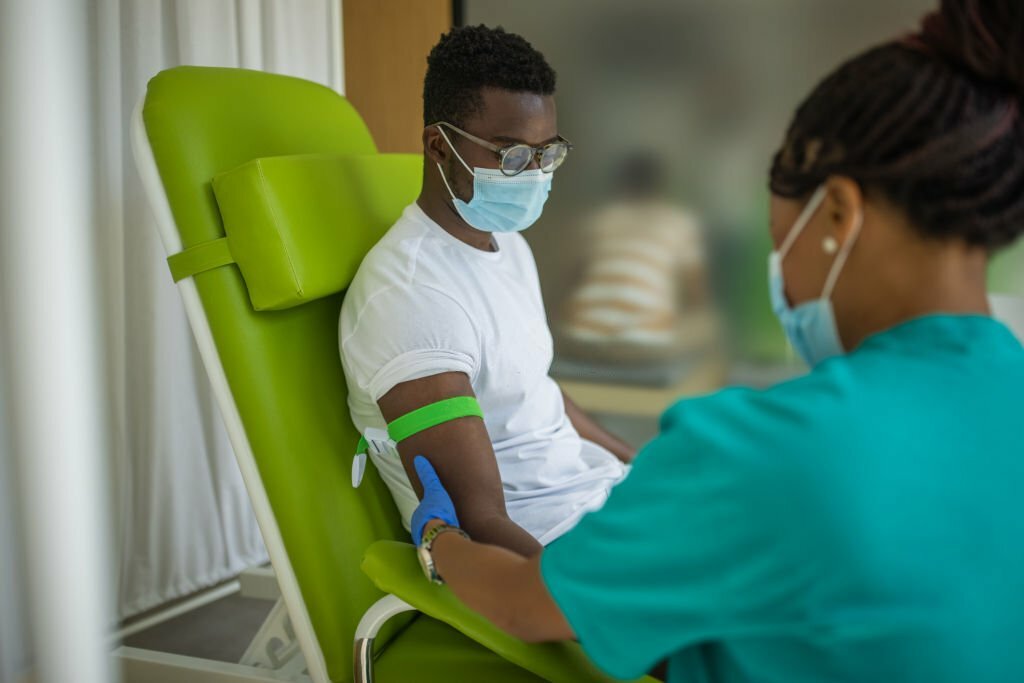
A Phlebotomist is a skilled healthcare professional trained in extracting blood from patients for various purposes, such as lab tests, transfusions, or donations. Their primary responsibility involves the collection of blood through venipuncture (using a needle to draw blood from a vein), finger pricks, or, in the case of infants, heel pricks.
These professionals commonly operate in diverse healthcare settings, including hospitals, medical offices, clinics, diagnostic laboratories, and blood donation centers. Phlebotomists fall under the category of allied medical professionals, encompassing healthcare practitioners—excluding doctors or nurses—with direct patient interaction in clinical environments.
Become A Phlebotomist In 7 Steps
1. Obtain Your High School Diploma or GED
To get in a phlebotomy training program or work as a phlebotomist, obtaining a high school diploma or GED is a prerequisite. If you still need to earn your GED, you can quickly sign up and complete the test online when prepared.
2. Research Phlebotomy Training Programs
Numerous training programs are available to become a phlebotomist, including online courses, part-time classes, and full-time accelerated programs. When considering a phlebotomy training program, explore online reviews, verify accreditation status, and inquire about exam preparation. Look for programs that provide assistance with job placement or career counseling.
For online courses, ensure they have effective methods for teaching blood drawing and needle handling. Look for programs that include an externship for hands-on skill practice. Certification agencies typically mandate in-person practice hours before you can qualify for your certification exam.
3. Enroll in a Phlebotomy Training Program
Before enrolling in a phlebotomy training program, you need specific prerequisites. Since you'll be working with patients, obtaining your CPR certification before starting may be necessary. Additionally, some programs may request a background and criminal record check.
Most phlebotomy training programs also mandate vaccination against common bloodborne diseases, considering the risk of needlestick injuries for phlebotomists.
4. Take Your Certification Exam
Several phlebotomy certifications are available, and there isn't a national standard for certification exams; the requirements vary slightly. Employers generally are not overly specific about the certification you hold. However, if you have a particular job or facility in mind, it's worth inquiring about their preferences.
5. Build Your Resume
Building a strong resume doesn't require perfect grades or extensive healthcare experience. Include extracurricular activities, awards, and leadership roles to showcase your skills. Before submitting your resume, have someone else review it for typing errors and offer suggestions on organization and formatting.
If you have a limited work history, obtaining a letter of recommendation from a teacher, coach, or supervisor can be advantageous. Third-party endorsements of your strengths can significantly impact your hiring prospects. Craft a compelling cover letter emphasizing why you would be a valuable addition to the healthcare team, which can offset any lack of experience.
6. Apply for Jobs
Websites like Monster and Indeed are excellent for discovering and applying for phlebotomy jobs. Some of these platforms even provide resume-building tools to enhance your chances of securing a position. Specific major healthcare organizations exclusively post job opportunities on their own websites.
Suppose you have a specific facility in mind. In that case, checking their website or contacting them directly to inquire about any job openings is advisable.
Before your official interview, practice answering a few questions with a family member or friend. This can help ease nerves and make you feel more prepared for the interview.
7. Maintain Your Phlebotomy Certification
Once you pass your phlebotomy exam and secure a job, it's crucial to maintain your certification, and the requirements may vary. Renewal intervals can range from annually to every two or four years. Typically, the recertification process involves completing several hours of continuing education or providing evidence of work hours, along with a recertification fee, generally around $100. It's essential to familiarize yourself with the specific requirements for your certification to ensure timely renewal.
What Is The Average Phlebotomist's Salary?
The annual salary for a phlebotomist in the United States, as reported by Salary.com and Indeed, is $39,422. The salary range typically spans from $35,510 to $44,029. However, variations in salary can be influenced by factors such as education, certifications, additional skills, and the number of years of experience in the profession.
FAQs
How Long Does It Take To Become A Phlebotomist?
The time required to become a phlebotomist varies based on factors such as the chosen school, training program, certifications pursued, and the course load. Typically, the process can take anywhere from four months to a year and a half. Expect to dedicate three months to a year for studying, practical training hours, and an additional 20-40 hours of coursework for certification.
Generally, about two-thirds of the phlebotomy training is conducted in the classroom, covering anatomy, physiology, and medical terminology. The remaining one-third involves practical training through internships and externships, providing hands-on experience.
